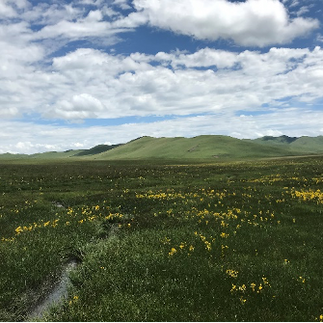Tibetan meadow ecosystem changed dramatically and complexly by human-mediated environmental changes
- ConScience
- Jul 26, 2023
- 3 min read
By Erliang Gao, a postdoc based at Lanzhou University
There are many types of meadow ecosystems on the Tibetan Plateau. Among them, alpine meadow, the most common one, is characterized by high plant diversity, and swampy meadow usually occurs around water bodies (e.g. rivers, lakes), and undertakes very important ecosystem functioning, such as water regulation and carbon storage, with relatively lower plant diversity. In recent decades, warming-induced evaporation and anthropogenic drainage have dried up many swampy meadows (16% in our study area) and transformed them into dry alpine meadows (swampy meadow desiccation). In some areas, poorly thought-out land use (mainly overgrazing) further destroyed the alpine meadows and transformed them into species-poor degraded meadows (alpine meadow degradation). A comprehensive understanding of the impacts of these human-induced meadow transformations is a prerequisite for the better conservation and restoration of these unique ecosystems and is our objective in this study.

Main framework and methodology used to explore multi-layered responses of Tibetan meadows to human-mediated transformations. Specifically, the diagram illustrates how the processes of swampy meadow desiccation and alpine meadow degradation impact species diversity and composition, interactions among organisms (ecological networks), and ecosystem functioning at multiple closely-related trophic levels.
To achieve our goal, we surveyed plants, plant-pollinator interactions, and soil microbes, in multiple sites of each type of meadow, and constructed pollination networks and soil microbial networks based on these data. Various indicators representing a range of ecosystem functions were also surveyed.
Our analyses show that, as a result of swampy meadow desiccation, species diversity and interaction complexity increased, both for above-ground plant-pollinator communities and below-ground soil microbial communities.
However, the increased complexity of the system didn’t always contribute to its stability; we found pollination networks became more robust, while soil microbial networks became more vulnerable to species loss as a result of swampy meadow desiccation. In terms of ecosystem functions, we found that the pollination function benefits from increased diversity in resources and the formation of dry soil in alpine meadows, but important below-ground functions (e.g. water regulation and carbon storage) decreased.
When extensive grazing pressure caused alpine meadows to degrade further, above-ground biodiversity and interaction complexity tended to decline. The soil microbes per se remained unchanged but associations among them homogenized; our network analysis suggested that soil microbes with similar characteristics tended to associate with each other. Compared to alpine meadows, ecosystem productivity and pollination function decreased in degraded meadows.
A swampy meadow (left) and an alpine meadow (middle). They are equally beautiful, but they are different in many ways, including aspects that we cannot see visually, make both of them unique and valuable. A degraded meadow (right), which has less value in biodiversity conservation and ecosystem functioning. The relatively resistant soil properties and soil microbes constitute good biotic and abiotic environments for restoration, action is needed right now before it’s too late.
Our findings highlight that ecosystem transformations can have contrasting effects on above-and below-ground diversity and ecological networks, as well as ecosystem functions.
Such contrasting responses call for targeted and nuanced management strategies to conserve biodiversity and ecosystem functioning in the Tibetan Plateau. For example, restoration of desiccated swampy meadows (e.g. by banning anthropogenic drainage and blocking water flow) is necessary and urgent to stop the emission of greenhouse gases. However, the location and extent of the restoration should be carefully considered, as transforming alpine meadows back to swampy meadows would decrease the species diversity of above- and belowground organisms, and impair the ability of meadows to support pollinator insects. With this in mind, landscape-level studies are needed to determine what layout is the best for maximizing regional biodiversity and ecosystem functioning. In addition, when we aim to restore degraded ecosystems, the effect of restoration on different aspects of the ecosystem should be verified, as they don’t always respond consistently. For example, in another study, we examined the effect of grazing exclusion (as a restoration method for degraded meadows) on species interactions and ecosystem functioning, as an important addition to previous studies, which only considered the restoration of plants and soil.
See original article in Functional Ecology, April 2023 | https://doi.org/10.1111/1365-2435.14333








Comments